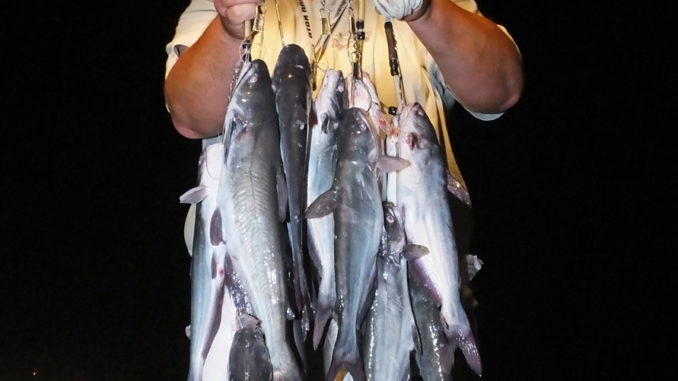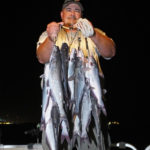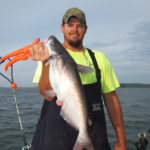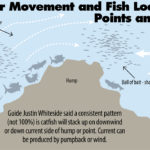
Targeting suspended catfish is the ticket to great hot-weather action on South Carolina’s Lake Monticello.
Fishermen know Lake Monticello is a world-class trophy catfish destination, but this deep, clear lake offers much more than just huge fish. Catching big numbers during the summer makes this 6,800-acre lake a top destination for quality and quantity catfish.
Monticello is teeming with blue catfish of all sizes. According to guides William Attaway and Justin Whiteside, targeting catfish by the numbers in July doesn’t eliminate the potential for catching a behemoth blue; it simply adds catching big numbers into the equation.
Attaway, from Pomaria, said July ranks high on his favorite times because fishing is good literally “round the clock.” Plus, a wide variety of techniques will produce catfish.
“I could not ask for more out of any lake for red-hot summertime catfish action,” Attaway said. “It’s still very reasonable to hook huge catfish, but it’s prime time to fill big coolers with eating-sized catfish — and we do it by day and night.”
Attaway’s bread-and-butter technique from mid-June through August is fishing late afternoon until after midnight.
“Fishing late afternoon and into the night is good in several ways. First, I get the low-light advantage of late- afternoon fishing and then the dark fishing at night,” he said. “The water here is very clear, and low light or dark is usually a positive; for one thing, it makes baitfish more active in shallower water. Plus, we get relief from the heat when the sun goes down. My experience over the past several years has been the action perks up just before sunset and stays strong until after midnight. I find forage and catfish shallower, and fish are on a more aggressive bite.”
Attaway uses a unique and highly productive technique.
“Fishing open-water targets, but drifting for suspended catfish, works well at Lake Monticello,”he said. “This type fishing is good during the day as well, but I simply prefer fishing at night during July. The bite is typically fast and as productive as any month. Most of the fish are blue catfish, with a few channel cats.”
Attaway said drifting for suspended may seem random to the untrained observer, but it’s actually a very refined, specific process.
“I’ll drift the open water for suspended catfish while fishing over specific bottom contour targets,” he said. “The water in Lake Monticello is very deep in some areas, but shallow humps and points exist throughout the lake. Catfish suspended in 20 to 30 feet of water will often position directly over underwater targets, even though they may be 10 to 30 feet above the lake bottom.
“I’ll drift over humps, long points that extend to very deep water and the top of the submerged standing timber,” he said. “The process is to find the specific target for a given night and work that structure. I control the depth of my rigs primarily by a combination of speed and weight on the line. My graph is a key component to the process, because I’ll see the fish and forage on the graph and can fish specific depths while working to determine the right combination of speed and weight.”
Attaway uses 7½-foot, medium-heavy Ugly Stik rods with 40-pound test line spooled on baitcasting reels. He prefers a 50-pound test leader and a 7/0 Gamakatsu circle hook; he’ll use one or two No. 4 split shot as weight. His preferred baits are chunks of chicken and cut bait, with shad and white perch being his preference.
“Once I hit the pattern for the evening, I’ll focus all my rigs on that target depth,” Attaway said. “I usually fish six rods rigged this way, but I’ll also have two down rods with heavier weight and much larger bait for big catfish. This is a technique primarily for numbers of fish, but the lake has some of the largest blue catfish in the state, so I give them a chance to load on.”
Attaway said he’ll usually begin a couple hours before dark and fish until the wee hours of the morning.
“It’s not that it’s just more comfortable, but I think the fishing is better,” he said. “Usually the water is pumped back into the lake at night, and that creates a good current in the lower end of the lake. The lower end is where I primarily fish this time of the year. The current seems to put the fish into an aggressive feeding mode, and that’s a key to make this suspended fishing click. Right at dusk, we generally experience a wild flurry of action. That’s another reason I want to be out and hopefully on fish by then.”
Attaway said sometimes the bite is steady, and around midnight, it really cranks up.
“The best way is to just get on the lake, enjoy the evening and let it play out,” he said. “We go home when we have more than enough fish to clean, and typically we’ll catch a bunch of blues on what I call the ‘midnight express.”’
As good as the fishing is at night, daytime fishing is just as productive, but different techniques apply.
Justin Whiteside of Rock Hill guides on Monticello, as well as Lake Wylie and Lake Wateree; he said June through August will produce excellent catfish action by day for trophy fish as well as big numbers.
“I prefer daytime fishing, and we’ll catch plenty of fish and have very good opportunity to hook huge catfish,” Whiteside said. “Catching catfish by day on Lake Monticello usually means working the humps and points, moving and searching for concentrations of fish. The water is clear, but plenty of deep water is typically nearby and I’ll find catfish near or in deep water. The summertime range for me is from 6 to 50 feet deep.
“I like to get on the lake early because forage is usually shallow then, and that’s where the catfish will be,” Whiteside said. “That’s a maxim for catfishing anywhere — find the forage, and you’ll find catfish. But the movement of forage in the clear water of Lake Monticello can be quite dramatic during the day, requiring me to constantly update my plan and fishing technique. I have to keep an open mind in terms of fishing deep because 50 feet of water is not deep at this lake.”
Whiteside (803-417-0070) said despite their huge appetite, Monticello’s catfish can be selective about the bait of choice on a given day, so he’s armed with a wide variety.
“I’ll bring live gizzard shad, live white perch and bream during the summer, and I’ll use cut bait from these species,” he said. “I’ll use big baits as well, live and dead, and all three of my largest catfish from this lake — 71, 65 and 61 pounds — have come on 14-inch gizzard shad. But a lot of the mussels blue catfish love to eat here are small, so I’ll mimic the ‘match the hatch’ concept, and I’ve caught plenty of huge catfish on small quarter-sized chucks of cut bait in hot weather.
“Even something as big as the elephant likes to eat peanuts, so I’ll give the catfish options on the size of bait I present,” he said.
Whiteside fishes points and humps early, typically in relatively shallow water. When he first gets on the water, he studies the graph and usually discerns a definitive bait line.
“This bait line is a direct clue to the depth I should begin fishing,” he said. “I’ll anchor and fish rigs in the shallow water where forage is most prevalent, but I’ll also work around the edges of the points and humps with baits in deeper water. If the fish start biting in the shallow water, but as the sun gets higher I begin catching them on deeper rigs, then I know the bait and the catfish are on the move to deeper water. My next setup will be deeper. By following this general pattern and moving to deeper humps and points I can stay on fish all day.”
Whiteside said he will drift for suspended fish during daytime and catches scads of fish up to 10 pounds, with the occasional big fish. He said more big fish are caught from the anchored position, based on his experience.
“I will drift-fish similar to what I do on Lake Murray, and this technique is effective,” Attaway said. “On Monticello, we have to avoid the large areas of submerged timber, or we’ll snag every rig and lose them all. Searching with the graph, I’ve found areas less than 60 feet deep where I can make extended drifts. I can also drift-fish, bumping the bottom, over a lot of points and humps. I often do this in combination with the suspended baits as well during the day.”
Attaway drifts with the standard “Santee Rig” with a big circle hook on a 24-inch leader and a 2-inch float set about a foot above the hook. Above the swivel, he adds 1 to 2 ounces of weight, with the slinky type weight preferred.
Whiteside and Attawy agree that forage and current are keys to finding the right depth and pattern for catfish, but Whiteside said the final key element is patience — which is usually rewarded.
“Some say this is a feast-or-famine lake, and that’s true to an extent,” he said. “But give the fish time to bite, fish areas where forage and fish are marked on the graph, use different baits and sizes of bait and odds of success are high. I may nail them at the first stop, or we may fish three or four humps with only moderate action. But when I hit the hot spot and fish turn on, we cure the summertime blues in a hurry.”
DESTINATION INFORMATION
HOW TO GET THERE — Lake Monticello lies between I-77 and I-26, with Pomaria to the west, Jenkinsville to the south and Winnsboro to the east the closest towns. A public boat ramp is just north of Lake Monticello Park off SC 215, and another is on the north end of the lake off SC 20-99.
WHEN TO GO — Lake Monticello produces both good numbers of blue and channel catfish, with some trophies mixed in, from mid-June through August.
BEST TECHNIQUES — Drift for catfish that are suspended over humps, the ends of long points and the tops of standing timber. Cut baits from bream, white perch and shad, along with chunks of chicken, can be productive. Use a standard Santee rig. Periods of low-light are particularly good, because baitfish and catfish will move into more shallow waters.
FISHING INFO/GUIDES — Justin Whiteside, 803-417-0070; William Attaway, Slick Willie’s Guide Service, 803-924-0857, www.slickwilliesguideservice.com. See also Guides and Charters in Classifieds.
ACCOMMODATIONS — Fairfield Motel, Winnsboro, 803-635-3458; America’s Best Value Inn, Winnsboro, Phone: 803-635-1447.
MAPS — Kingfisher Maps, 800-326-0257; www.kfmaps.com.








Be the first to comment